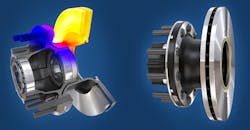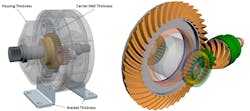Here Comes the Simulation Revolution! Part 3
Part 1 of this series introduced a growing movement commonly referred to as Democratizing Simulation. That is: the ability to capture and extend the knowledge and experience of engineering simulation experts throughout an organization. Results are accelerated development cycles, greater innovation, and a higher return on simulation investments. In Part 2 we discussed the business challenges and return on investment associated with adopting the initiative. We also showcased a couple industry success stories. This installment will get into the nuts and bolts of how it works.
Implementation: Enabling Technologies
Democratizing Simulation can take on a variety of forms. Regardless of where or how it is implemented the goal remains the same: to streamline product design validation by taking full advantage of analysis/simulation resources and investments. A residual effect of this is more freedom for senior analysts and other simulation experts to focus on more advanced or higher-priority simulation projects. With a variety of available implementation options, companies have a great flexibility when it comes to where, and to what degree they wish to implement the process.
A NASCAR engineer turned to simulation and the Ohio Supercomputer Center to help drivers better understand the performance factors that must be controlled to keep them competitive and safe. (Courtesy: The Ohio Supercomputer Center)
How it Works/Enabling Technologies
For those interested in taking a next step, or just wanting to kick the tires a little, there are multiple entry points for implementation. Of these the most common include:
Simulation Governance & Standardization
All major industrial organizations employ numerical simulation in support of engineering and business decision-making. Therefore, using numerical simulation is no longer a differentiator. The question is: How safely and reliably is numerical simulation is being used?
Depending on the answer, numerical simulation can be a significant corporate asset or a potential liability. Whenever engineering or business decisions are based on the results of numerical simulation there is an implied expectation of reliability. Without such expectation it would not be possible to justify the time and cost of a simulation project. In fact, if simulation produces misleading information it has a negative economic value. Simulation Governance is the term used for the techniques and processes that are used to ensure that simulation provides accurate and validated results.
Simulation Process & Data Management (SPDM) and the Enterprise Digital Thread
Traditionally, simulation data, processes, and experts have operated within various silos in the organization. Hence, this valuable expertise and data has not been an integrated part of enterprise engineering processes. Furthermore, organizations are now striving to manage their engineering data and processes in a more consistent manner, connecting these into what is being called a Digital Thread. Any engineering data that exists within silos is, by definition, left out of the Digital Thread—simulation data is such an example.
To make simulation data an integral part of the enterprise Digital Thread requires what is being called Simulation Process and Data Management (SPDM). These SPDM capabilities need to be integrated into the enterprise data management platform called Product Lifecycle Management (PLM). With this approach, accurate, up-to-date simulation data becomes available for timely decision-making.
Intelligent Automation Templates
Simulation Automation using automation templates has been used by many organizations to significantly improve the accuracy, consistency, repeatability, and efficiency of performing complex simulations. These intelligent templates capture and embed the experience of the experts in the form of rules. When a template is executed, these rules are automatically enforced. Templates not only allow non-experts to safely and robustly run simulations, but often also make the experts more efficient and accurate.
Furthermore, intelligent simulation automation is also key to enabling a wide range of other strategic corporate priorities, including:
- Digital Thread Traceability within the PLM Backbone
- Digital Twin Analysis for Predictive Maintenance and Design Improvements
- Design Space Exploration
- Generative Design
- Quality Assessment of Additive Manufactured Products
At their core, each of these requires mainstreaming simulation automation, and data management to work robustly across significant (and unpredictable) design changes and entire product families that share common functional/architectural characteristics. The current, manual, inefficient, and siloed simulation process must be replaced by CAD-enabled, “lights-out” automation that is safely accessible across the product development team.
Simulation Apps
The use of Sim Apps (simple-to-use apps that drive underlying Simulation Automation Templates) has put the power of simulation in the hands of non-experts in many product development organizations. It is important that experts be able to create Sim Apps rapidly and easily. Specialty tools and Low-Code Development Platforms enable the creation of Sim Apps with little or no hand-manual coding; this in-turn allows those closest to the design process to build the apps rather than relying on IT developers. Increasingly, Sim Apps are browser-based, and with authorized access into a corporate network one has access to the apps without any need to have locally installed software, eliminating yet another historical constraint of simulation and modeling.
System Simulation
System simulation is the ultimate arbiter of whether a product design is meeting given performance objectives. As such, system simulation incorporates the end effects of all subsystems and components in determining overall product performance. Throughout engineering design and simulation circles, system-level simulation has been synonymous to Model-Based Systems Engineering (MBSE), which the International Council on Systems Engineering defines as a “formalized application of modeling to support system requirements, design, analysis, verification and validation activities beginning in the conceptual design phase and continuing throughout development and later life cycle phases.” However recently, with the advent of the Digital Twin and the Internet of Things (IoT), MBSE is now viewed as a subset of System Simulation.
In addition to MBSE, System Simulation now includes items such the methods for combining different data sources (physics-based predictions, test data, field data, etc.) that are statistically analyzed to make a business decision—as opposed to simply an engineering design decision. It has also expanded its reach to include not only engineering design decisions, but the entire product experience lifecycle, including product conception, manufacturing, field usage, and so on.
Digital Twins
Physics-based simulation models have proven their mainstream business value during the design, development and manufacturing phases of the Product Performance Life-cycle (PPL). Now they are moving into the entire life cycle of products and systems. Models are being updated/modified to reflect the ongoing true in-field status/condition of such products/systems and by being subject to the actual in-field loadings and boundary conditions obtained from sensors (the Industrial Internet of Things - IIoT). The resulting Digital Twins can then be used to anticipate and schedule maintenance and predict the behavior of future proposed operational modifications and/or design changes (repairs or retrofits) to the physical structures and systems they represent in digital form.
Digital Twin components/ingredients have been around for a while, but their synergistic combination is just now bearing initial business fruit. Key enablers are the increasing physical accuracy of CAE models, the declining costs of high-performance computing (HPC), expanding cloud HPC accessibility, and low-cost sensors. As these Digital Twin-based workflows throughout the PPL become more prevalent, the result is that many more CAE simulations will be built into those workflows and executed more and more frequently and routinely (even in a more automated way). The automation of such workflows will democratize simulation number of simulations being routinely executed) without necessarily requiring a great increase in trained CAE engineering talent to run them. Such talent will spend more value-added productive time in creating and automating the Digital-Twin-based workflows.
High Performance/Cloud Computing
High Performance Computing (HPC), Advanced Modeling, Simulation & Analysis, Technical Computing, Cluster Computing, or Parallel Computing refers to computers at the frontline of current computational processing capacity. Why use HPC? For some situations, experimentation may not be adequate to test theories because things may be too small to see and measure, systems may be too large and remote, or processes can be too fast or too complex. Alternatively, simulations or analyses might take too long or the size of the data is too large to be contained on a personal computer. Traditionally, accessing HPC has required a relatively high level of knowledge of networks and the use of esoteric interfaces—expertise usually found in IT groups. New approaches and interfaces are now available that make the use of HPC networks, either within corporate networks or on the Cloud much easier, resulting in the democratization of HPC.
SimApps, such as this Gearbox SimApp, empower product development teams while providing feedback to the engineering team for refinement of future designs. Engineers with limited CAE expertise can now safely and robustly run complex simulations. (Courtesy: Aras)
Solution Providers
From large corporations to single-person consultants and everything in between, there seems to be no shortage of available resources to help plan and/or execute a program to democratize simulation. Thought leaders and solution providers throughout this realm include, but are not limited to, companies like ANSYS, Aras, ASSESS, AweSim/Ohio Supercomputer Center, Beyond CAE, EASA, ESRD, ESTECO, Front End Analytics, Kinetic Vision, Modelon, NAFEMS, NTP Truboprovod, PLM Alliances, Rev-Sim.Org, UberCloud, Vcollab, and more. These and other companies provide the expertise, tools and assistance to help make engineering simulation more accessible, efficient, and reliable. Find a list of these and other solution providers here.
Catch the Building Wave
The role of the CAE expert is changing. In the past this valued resource once focused exclusively on running simulations. Today these men and women are taking on an even greater role of capturing and extending/multiplying their experience and expertise throughout the organization. Results are measurable and sustained: accelerated development cycles, improved innovation, greater quality, and increased productivity/profitability.
A revolution is underway to more fully leverage the power of engineering simulation throughout the organization. Take the time to become more familiar with Democratizing Simulation and think about where and to what degree your company may want to begin implementing. There’s plenty of information available out there, and www.rev-sim.org is one example.
Up Next
The engineering simulation and analysis ecosystem is populated by numerous simulation associations, organizations, and alliances whose work contributes to the development, adoption, and maturation of new technologies which expand the reliable use of simulation. In the final installment of this series we’ll look at a few of these organizations and discuss the similarities and differences between them.



